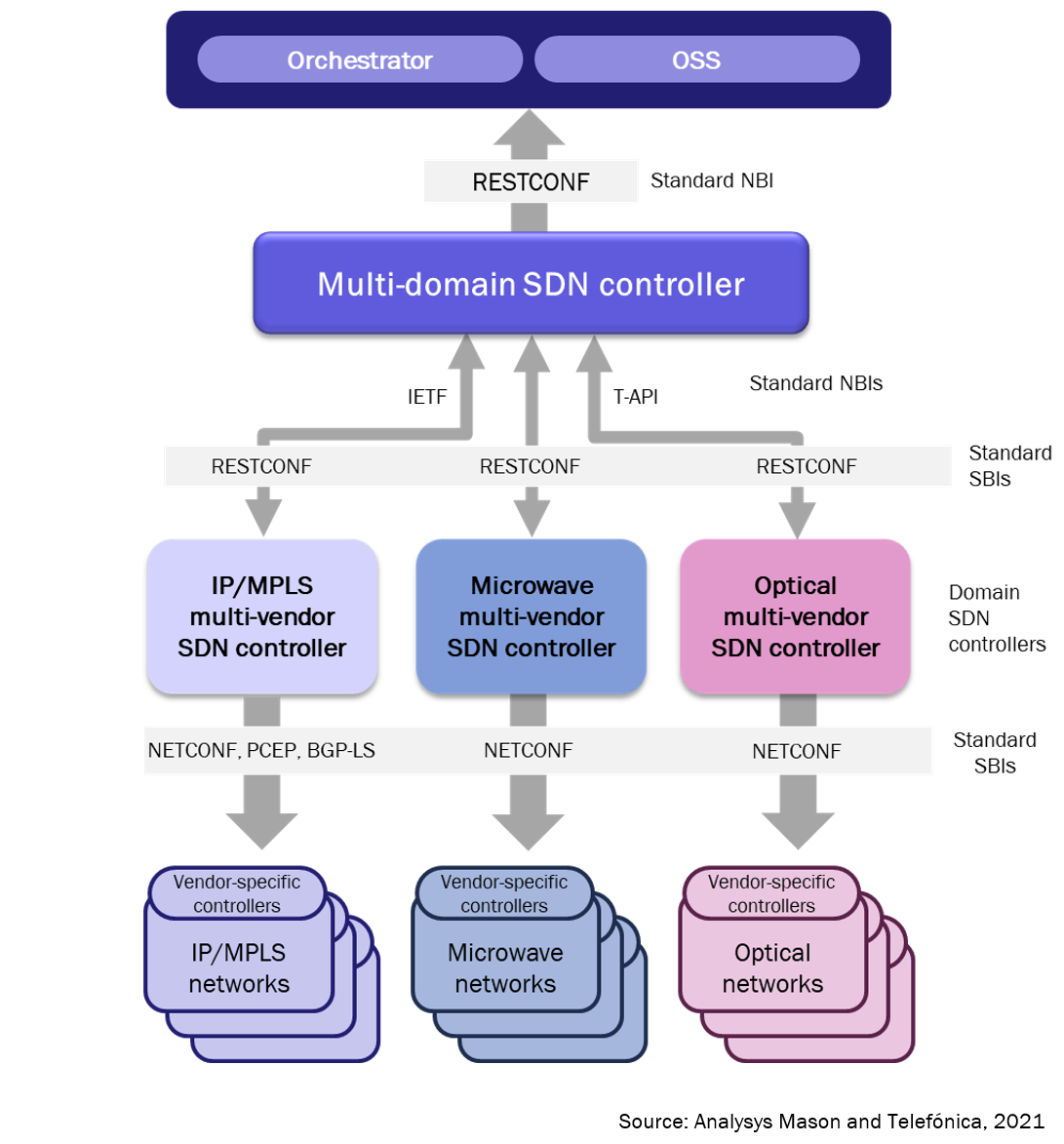TIP’s transport SDN workstream, MUST, puts CSPs in control of network automation
Six leading communication service providers (CSPs), Deutsche Telekom, MTN, Orange, Telefónica, Telia Company and Vodafone, have joined forces to standardise the open transport SDN architecture and achieve vendor-agnostic network programmability. The prevailing diverse SDN standards and automation frameworks have caused confusion and have slowed down network automation progress. This collaboration is therefore an important milestone; CSPs are taking control of the standardisation process, to not only accelerate transport network automation, but also to prepare for 5G network slicing.
The CSPs are working together as part of the Telecom Infra Project Open Optical and Packet Transport (TIP OOPT) project group and have launched a new workstream titled Mandatory Use Case Requirements for SDN for Transport (MUST). The group will create technical use case specifications, focusing on key topics such as partial optical network disaggregation, IP and optical multi-domain and multi-layer co-ordination and network slicing. It has already released a white paper (Open Transport SDN Architecture Whitepaper), which provides an in-depth explanation of the MUST initiative.
 Anil Rao is the Research Director and Lead Analyst for network and service automation research at Analysys Mason, covering a broad range of topics on the existing and new-age operational systems that will power operators’ digital transformations. His main areas of focus include automation of service creation, provisioning and service operations in NFV/SDN-based networks, 5G, IoT and edge clouds; the use of analytics, ML and AI to increase operations efficiency and agility; and the broader imperatives around operations automation and zero touch networks.
Anil Rao is the Research Director and Lead Analyst for network and service automation research at Analysys Mason, covering a broad range of topics on the existing and new-age operational systems that will power operators’ digital transformations. His main areas of focus include automation of service creation, provisioning and service operations in NFV/SDN-based networks, 5G, IoT and edge clouds; the use of analytics, ML and AI to increase operations efficiency and agility; and the broader imperatives around operations automation and zero touch networks.
Fragmented industry standards have slowed down the large-scale adoption of transport SDN
The Telecommunications industry depends on standards, which allow network equipment providers, software vendors, systems integrators, and network operators to rapidly build and commercialise products and services at scale, obviate interoperability issues, and de-risk vendor swap-outs. However, when it comes to SDN and transport network automation, the industry has made slow progress on standardisation. While industry bodies such as the IETF, MEF, ONF and TM Forum have done tremendous work in defining frameworks, network control architectures and interface specifications for SDN-enabled programmable transport networks, these efforts have been largely independent and led to fragmentated standards and proprietary implementations.
A group of six leading operators are collaborating to address this issue head on; the result of their efforts is the Mandatory Use Case Requirements for SDN for Transport (MUST)workstream within the TIP OOPT working group.
The MUST workstream aims to harmonise the telecoms industry’s approach to transport SDN control and automation
The MUST workstream operates on the following three key principles:
- Establish a common target reference architecture for transport SDN control. The target architecture will consist of a hierarchy of SDN controllers; each of the transport network domains (IP, optical and microwave) will have a domain-specific, multi-vendor SDN controller. A higher-layer, multi-domain SDN controller will provide another level of abstraction over multi-vendor SDN controllers, thereby enabling the unified multi-layer management of all transport networks. The multi-domain controller will communicate with the operation support systems (OSS) via standards-based open APIs in order to gather the information needed for service orchestration, fulfilment and unified inventory management (Figure 1).
Figure 1: Transport SDN reference architecture used by Telefónica
- Curate relevant interfaces and data/service model. The northbound interfaces (NBIs) between the multi-vendor SDN controllers and the multi-domain SDN controller will be based on RESTCONF. YANG and NETCONF will be used for the data models. IETF is developing the NBI for IP/MPLS networks, the ONF transport API has been chosen for the optical network and the standardisation of the NBI for the microwave network is still underway.
- Adopt an agile use-case-driven approach to operationalising transport SDN. CSPs will continually define and prioritise the use cases for implementation, thereby allowing them to realise continuous benefits. The technical use case specifications (for example, for the northbound and southbound interfaces) will also become a central part of a vendor’s requirements document (such as an RFP) and solution development process, thereby allowing CSPs to demand vendors to comply with their roadmap.
The principles, together with technical use case specifications, provide the foundation upon which CSPs, standards bodies and vendors can work towards building a common, standardised architecture.
Telefónica is using the MUST framework as part of the iFUSION strategy to automate its Transport networks
In accordance with the MUST framework, Telefónica Germany has implemented a hierarchical SDN controller architecture for its partially disaggregated optical network, which includes decoupled open terminals (OTs) and an open line system (OLS). It has deployed Blue Planet’s MDSO as the multi-vendor software defined transport network (SDTN) controller in order to manage the multi-vendor optical network. The CSP has implemented five key network automation use cases based on the MUST framework: automated network discovery, OT inventory discovery, service topology management, service management and alarms management.
Learn more about this deployment in the Analysys Mason Case Study: Telefónica Germany is partnering with Blue Planet to execute its iFUSION transport SDN strategy
The MUST workstream puts CSPs in control of their destiny
The diverse range of SDN standards and automation frameworks has caused confusion and have slowed down the transport network automation progress. However, it has also enabled CSPs to learn valuable lessons and gain first-hand experience in building and operationalising SDN-based transport networks. CSPs must build on this experience and make a concerted effort to increase the pace of network automation, not only to provide differentiated and agile connectivity services, but also to build the basis for supporting new 5G services, such as network slice-based enterprise services.
CSPs’ success in their automation journeys is dependent on their vendor partners, but vendors need a clear direction to drive their product strategies. The industry fragmentation has forced vendors to build products that comply with a range of standards and specifications, thereby slowing the overall pace of innovation. At the same time, vendors have developed proprietary solutions to stay competitive and to meet the demands of CSPs that want to press ahead with implementations to achieve immediate business goals. CSPs and vendors realise that this is not an efficient way to scale their businesses.
The MUST workstream balances the needs of CSPs and vendors and has the potential to deliver all the benefits of standardisation. However, it will only do so if CSPs and vendors take the right actions. It puts CSPs firmly in control of their transport network automation strategies and allows them to increase the pace of automation without compromising on standards. It also provides vendors with certainty and clarity of direction so that they can efficiently allocate resources to development so as to innovate more quickly and build a profitable business.


